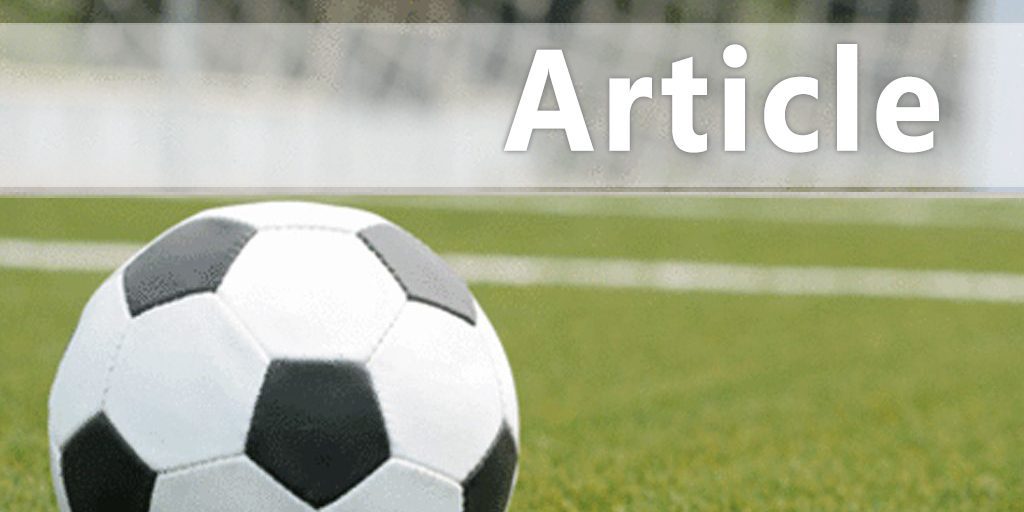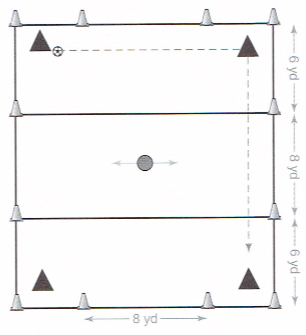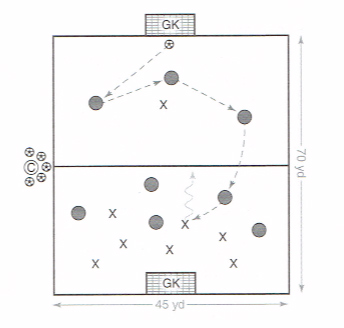| Counterattacking Drills |
| By: Dick Bate and Ian Jeffreys
Originally Published in: Soccer Speed Provided by: Human Kinetics INTERCEPT THE PASS AND COUNTERATTACK Purpose Intercepting passes and counterattacking Organization Set up an area that measures 20 yards (or meters) by 8 yards and divide it into three zones as shown in the diagram. Set up two small goals at each end with cones for a total of four goals. Position two attackers in each end zone and one defender in the middle zone. One attacker has a ball. Procedure 2. The two attackers who receive the ball try to transfer it to the attackers in the opposite end zone by passing it, below head height, past the defender in the middle zone. 3. The defender, who is free to operate anywhere in the middle zone, tries to intercept the attackers' passes. 4. Upon gaining possession, the defender runs with the ball and tries to either pass through one of the small goals or run over the end line with the ball. Coaching Points • Read the intent of the player in possession. • In response to lateral passes, slide or shift sideways with the feet apart, the knees bent, and the upper body leaning forward. • Move quickly - usually laterally - to intercept passes and even slide or go to the ground to intercept the ball or deflect it away from its intended receiver. • Upon contacting the ball, move it forward as early as possible by running it at the opponents and through a goal or over the endline. Variations • Use two defenders in the middle zone. • Increase the area's width to 10 or 12 yards (or meters). INTERCEPTION Purpose Intercepting passes. Organization Set up four cones 25 yards (or meters) apart and four additional cones 5 yards outside of the first four. As shown in the diagram, position two attackers at each cone and (optionally) two target players in the middle area. One attacker has a ball. Procedure 1. Attacker 1 runs with the ball for about 15 yards (or meters) before passing to attacker 2 with pace. The cones marking the corners of the square are 25 yards (or meters) apart. 2. Attacker 3 anticipates the pass to attacker 2 and steps forward to intercept it. Attacker 2 now replaces attacker 3, and attacker 1 becomes attacker 2. 3. If target players are included in the practice, they help the intercepting player by acting as possible receivers of his or her one-touch pass after the interception (or wall pass if the intercepting player runs with the ball). 4. Attacker 3 runs about 15 yards (or meters) before passing to attacker 4. 5. Attacker 5 anticipates the pass and steps forward to intercept it. 6. Attacker 4 now replaces attacker 5, and attacker 3 becomes attacker 4. 7. Play continues in this manner. Coaching Points • Anticipate the pass release by the player running with the ball. • Upon intercepting a pass, the first contact is vital and should be pushed well ahead of the feet in order to cover ground quickly, or the first touch should be used to pass to target players who then return the pass to the running player. • When running with the ball, keep the head up and the eyes able to see the position and movement of the ball and other players. • Release passes off of either foot using various surfaces to contact the ball. PREPARING THE COUNTERATTACK Purpose Defending to counterattack Organization Set up an area that measures 70 yards (or meters) by 45 yards and divide it into two halves. Position a goal at each end. Form two teams of equal number (8v8 or 9v9), including goalkeepers. Teams occupy their respective halves as if a kickoff was taken to start the game. Procedure 1. The game is started by the coach, who serves the ball to either of the goalkeepers who initiates an attack for his team. 2. Upon losing possession after an attack, a team is allowed only one defender in the attacking half of the area; the attacking team can have an unlimited number of player in the area. 3. The defending team drops into its own defending half, tries to regain possession, and, if successful, attacks from its position. 4. After a goal, the game commences with another kickoff or the coach feeds the ball to the goalkeeper on the team that scored. Coaching Points • The one defender in the attacking half is unlikely to succeed at pressing the opponent's possession and thus drops toward the half line, cutting off passes into the central areas, then assumes an appropriate position and prepares to participate as an outlet for a pass from a deep regain of possession. • The defenders in the defending half mark press the ball and move together as the ball is passed across and around the defensive structure. •From their marking and covering positions, defenders should read the play and try to intercept passes and otherwise spoil the opponent's possession. • Upon any type of possession regain, defenders should try to progress the play quickly and early by using forward passes or moving forward with the ball as appropriate. • If a counterattack cannot be initiated, the team should build a goal through accurate passing sequences that progress the play into a scoring position. |









